History
The building was established as a public house by 1812, when a women's friendly society met in the building [2] once a month. The women paid small amounts into a fund which they then withdrew in times of being unable to work due to childbirth, sickness, accidents or old age.
In 1822, William Jones became the licensee of the house "known as the Barley Mow", and from that point on he and his family ran the pub until the last quarter of the 19th century. In 1887 the Loyal Trafalgar Lodge of Druids Friendly Society had their Jubilee Dinner at the Barley Mow with over 100 guests, at which point Mr Teague was the landlord. [1] Later licensees included the Wakin, Stead, and Harley families. [1] By 1939, Ind Coope & Allsopp supplied Burton Ales to the pub; this continued until the late 20th century. [1]
Originally a row of three cottages stood between Monnow Bridge and the Barley Mow, but these were demolished in the 1950s. Heather Hurley, in her book The Pubs of Monmouth, Chepstow and The Wye Valley, thought that these three cottages may have been the site of a former pub called The Dolphin between 1721 and 1858. That area is now The Gatehouse's beer garden, with a balcony overlooking the River Monnow and Monnow Bridge. [1]
In Keith Kissack's 2003 book on Monmouth and its buildings he suggested that it was one of the best known inns in Monmouth for some 200 years. The vicar of Overmonnow in 1883 said that the Mayor had acted disgracefully, at the then Barley Mow, when the Mayor and 21 Elite men of the town had managed to drink 48 bottles of champagne, as well as some other wines while at the Mayors Luncheon. [3]

Monmouth is a town and community in Wales. It is situated where the River Monnow joins the River Wye, 2 miles (3.2 km) from the Wales–England border. Monmouth is 30 miles (48 km) northeast of Cardiff, and 113 miles (182 km) west of London. It is within the Monmouthshire local authority, and the parliamentary constituency of Monmouth. The population in the 2011 census was 10,508, rising from 8,877 in 2001. Monmouth is the historic county town of Monmouthshire although Abergavenny is now the county town.

Monnow Bridge, in Monmouth, Wales, is the only remaining fortified river bridge in Great Britain with its gate tower standing on the bridge. Such bridge towers were common across Europe from medieval times, but many were destroyed due to urban expansion, diminishing defensive requirements and the increasing demands of traffic and trade. The historical and architectural importance of the bridge and its rarity are reflected in its status as a scheduled monument and a Grade I listed building. The bridge crosses the River Monnow 500 metres (1,600 ft) above its confluence with the River Wye.
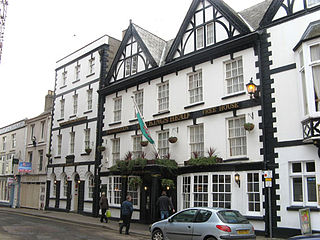
The King's Head Hotel is a hotel standing opposite the Shire Hall in Glyndŵr Street, Agincourt Square, Monmouth, Wales. It dates from the mid-17th century, and as one of the major inns in Monmouth was reputedly visited by Charles I of England in 1645. It has a fine black-and-white painted stone façade and became an important posting inn in the late 17th century, with a yard through an archway where visitors' horses could be stabled and where regular coach services called. In the 18th and 19th centuries, stagecoaches for London left from the inn. The range of buildings along Agincourt Street now includes the former Monmouth Bank and the County Club, while the inn itself is now part of the J D Wetherspoon pub chain. It is one of 24 buildings on the town's Heritage Trail and is a Grade II* listed building.

St Mary's Roman Catholic Church, in St Mary's Street near the centre of Monmouth, is the earliest post-Reformation Catholic public place of worship to be permitted in Wales. The church is a late Georgian Roman Catholic church with later Victorian additions by the Catholic convert architect Benjamin Bucknall. It has been designated as a Grade II listed building since 15 August 1974, and is one of 24 buildings on the Monmouth Heritage Trail.
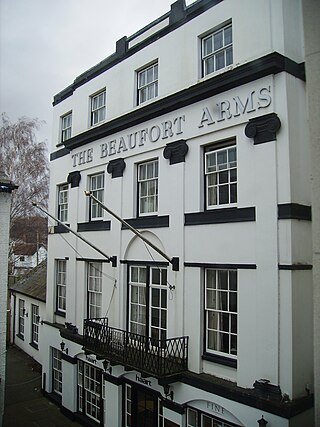
The Beaufort Arms Hotel, in Agincourt Square in the town of Monmouth, south-east Wales is a former coaching inn dating from the early eighteenth century. The frontage was modified in the 1830s, possibly by the prolific early Victorian architect George Vaughan Maddox. A stone cornice on the central block carries the inscription "The Beaufort Arms". A Grade II* listed building, it features in the Monmouth Heritage Trail. In the 20th century, the building was converted to residential apartments.

Overmonnow is a suburb of the town of Monmouth, in Wales, which is located to the west of the River Monnow and the Monnow Bridge. It developed in the Middle Ages, when it was protected by a defensive ditch, the Clawdd-du or "Black Dyke", the remains of which are now protected as an ancient monument. In later centuries the area became known as "Little Monmouth" or "Cappers' Town".

The Cross is situated in St Thomas' Square, Overmonnow, Monmouth, Wales, in the middle of a roundabout opposite the Church of St Thomas the Martyr and the western end of the Monnow Bridge. Originally mediaeval, and also known as Overmonnow Cross, the cross was reconstructed in 1888 and has been classed as a Grade II listed structure since 15 August 1974.

The Queens Head is a public house located at 1, St James Street, Monmouth, Wales. It has also known as The Queens Head Hotel and formerly Queens Head Inn.
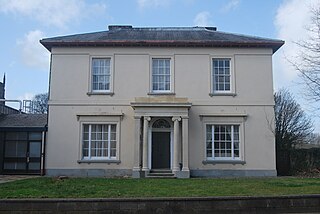
Oak House is a Grade II Listed building on Monk Street Monmouth, Wales.

The Punch House is a public house and hotel located at Agincourt Square, Monmouth, Wales.

Agincourt Square is an open space in the centre of Monmouth, Wales, in front of the Shire Hall. The area has been used for public functions and markets over the centuries.

The Three Horseshoes is a public house in Drybridge Street in the Overmonnow area of Monmouth, Wales. The pub has also been used as an Inn and also known as The Three Horse Shoes Inn. The building has been a Grade II Listed building since 15 August 1974. Appears of 19th century but of C17th origin. 2 storeys, roughcast as stone with a hooded doorway

The Vine Tree is a public house situated in Monnow Street in the town of Monmouth, Wales. The building has been a Grade II Listed building since 18 November 1970.
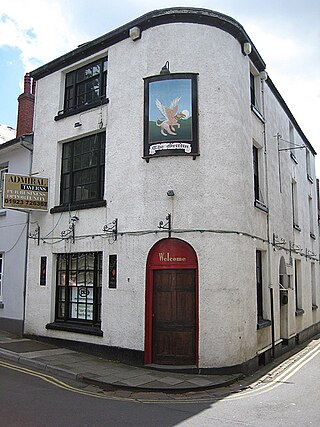
The Griffin is a former public house in Whitecross Street, Monmouth, Wales. The building dates from the 18th century and has been grade II listed since 2005. Its name and sign refer to the legendary creature, the griffin.
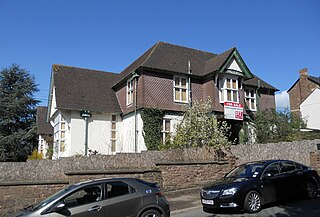
The Cottage Hospital was a community hospital on the Hereford Road in Monmouth, Wales.

The Mayhill Hotel is a public house and hotel located Wyesham Road, Monmouth, Wales. The pub is situated between the roads leading to Wyesham and the Forest of Dean and as such claims it is the Last Pub in Wales.
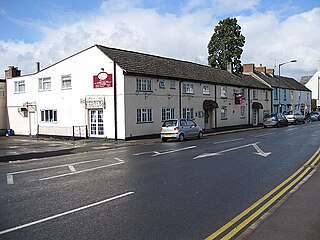
The Riverside Hotel is a public house and hotel located in Cinderhill Street, Monmouth, Wales. The hotel has a bar and a function room and has 17 bedrooms.

Monnow Street is the main shopping street of Monmouth, south east Wales. It runs for about 500 yards in a south-westerly direction from Agincourt Square to the Monnow Bridge, which crosses the River Monnow.

The Green Dragon is a public house and inn located in St Thomas Square Monmouth, Wales. The pub provides live music on weekend evenings and during the annual Monmouth Festival the pub is used as a venue for entertainment.
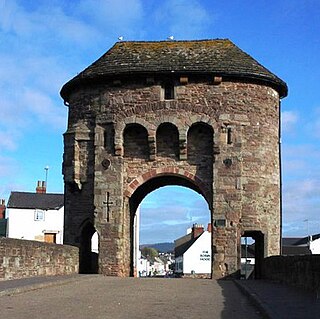
The Monmouth town walls and defences comprise the defensive system of town walls and gates built in Monmouth, Wales between 1297 and the early part of the following century. Wye Bridge Gate, East Gate, Monk's Gate, and Monnow Bridge Gate were access points to the town. West Gate, across Monnow Street, also provided access. Only the Monnow Bridge Gatehouse survives intact, albeit in a substantially modified version from the original.























